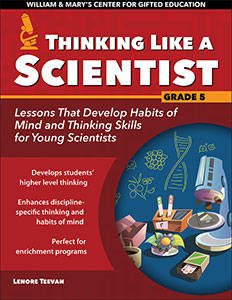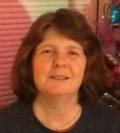Develop Habits of Mind in Young Scientists
Thinking Like a Scientist: Lessons That Develop Habits of Mind and Thinking Skills for Young Scientists
By Lenore Teevan
(Prufrock Press, 2019 – Learn more)
This handy lesson guide is part of the “Think Like . . .” series from the William and Mary Center for Gifted Education that aims to help students develop discipline-specific thinking and habits of mind – in this case for science.

The book contains pre- and post-assessments, and while they are primarily in a multiple-choice format, they would be easy to convert to an open-ended format. The book also discusses the use and organization of a student science notebook (much as a scientist would keep).
The elements of science
There are five units that are laid out in a logical order, each providing several lessons to build the skills being focused on in the unit.
➤ Unit 1 focuses on types of scientists and what they do.
➤ Unit 2 focuses on the scientific method and the thinking skills needed to evaluate hypotheses and data, including visual representation (making and analyzing graphs).
➤ Unit 3 addresses the changing nature of science, analyzing claims, and uncovering misconceptions.
➤ Unit 4 continues this progression with a strategy to help students with critical thinking and addresses the use of claims, evidence and reasoning (a key component of scientific investigation). This unit also includes making models.
➤ Unit 5 rounds out the book with three projects to put these “thinking skills” to work, including templates to facilitate student-led planning and group work.
Everything you’ll need for each lesson
Each lesson is well laid out and includes a list of resources and materials, the estimated time, the objectives, content and prior knowledge. These are clear and concise and support a teacher’s background knowledge.
The instructional sequence offers steps that are clear, concise and thorough and includes questions for discussion, extension activities, assessment observations, full-size student pages (ready for copying), and rubrics where appropriate. Answer keys are also included at the back of the book, as is the Next Generation Science Standards alignment.
Thinking Like a Scientist is a very handy guide that is extremely well written and truly addresses key components (at a middle-grades level) of how scientists do their work. And although the target audience is advanced fifth graders, the lessons could easily be used or slightly tweaked to use at any middle school grade level. I recommend this book for all middle-grade science teachers.
Dr. Laura Von Staden is currently a Middle School Gifted Math and Science teacher in Tampa, Florida. Prior to her middle school education career, Dr. Von Staden was a research scientist in the field of Molecular Immunology. She serves on numerous committees in her school district, works closely with the local university, and writes curriculum. She is also a professional development consultant, and previously served as an Exceptional Student Education Specialist and as a mentor.


































